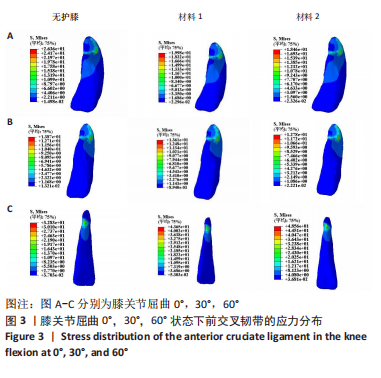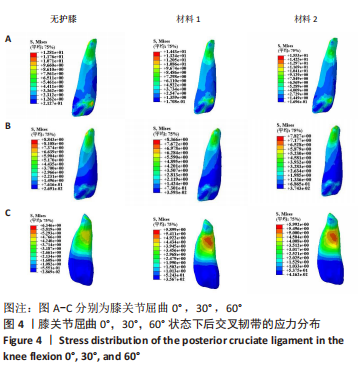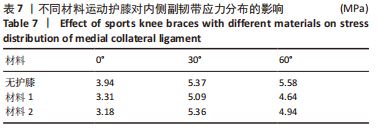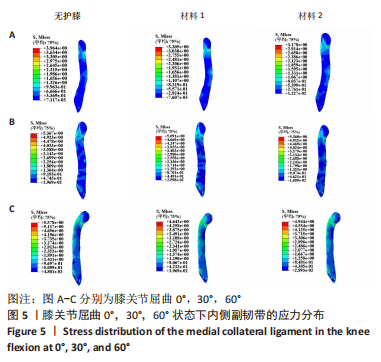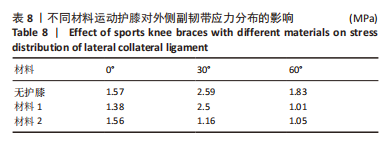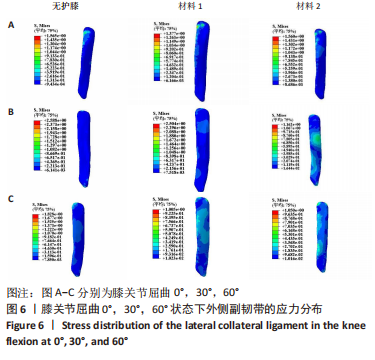Chinese Journal of Tissue Engineering Research ›› 2023, Vol. 27 ›› Issue (36): 5771-5777.doi: 10.12307/2023.733
Previous Articles Next Articles
Finite element method for predicting the effect of sports knee brace on knee ligaments under different sports conditions
Zeng Lulu, Xie Hong
- School of Textile Fashion, Shanghai University of Engineering Science, Shanghai 201620, China
-
Received:2022-10-17Accepted:2022-11-25Online:2023-12-28Published:2023-03-24 -
Contact:Xie Hong, PhD, Professor, School of Textile Fashion, Shanghai University of Engineering Science, Shanghai 201620, China -
About author:Zeng Lulu, Master candidate, School of Textile Fashion, Shanghai University of Engineering Science, Shanghai 201620, China -
Supported by:the National Key Special Research and Development Plan, Active Health and Aging Science and Technology Response Project of China, No. 2018YFC2000900 (to XH)
CLC Number:
Cite this article
Zeng Lulu, Xie Hong. Finite element method for predicting the effect of sports knee brace on knee ligaments under different sports conditions[J]. Chinese Journal of Tissue Engineering Research, 2023, 27(36): 5771-5777.
share this article
Add to citation manager EndNote|Reference Manager|ProCite|BibTeX|RefWorks

2.1 膝关节模型验证 膝关节在受到134 N后向推力时,股骨在前后方向上的位移为3.92 mm,与前人研究结果相似,其中GABRIEL等[20]为尸体实验,SONG等[21]、万超等[22]和何川等[15]均是有限元模型;前交叉韧带、后交叉韧带、内侧副韧带及外侧副韧带的峰值应力分别为19.95,8.84,4.0及1.15 MPa,从韧带受力分析可知,前交叉韧带的受力载荷大于其他主要韧带,各条韧带的峰值应力均出现在胫骨、股骨附着区,这与临床诊断前交叉韧带是防止胫骨前移的主要作用,且膝关节韧带损伤主要集中在骨骼止点部位的临床现象相一致[21,23]。 2.2 膝关节-护膝模型验证 在模拟膝关节分别穿上两种护膝后,提取膝关节测量点的接触压力,并与服装压力测试数据进行对比。首先对模型测量点进行设定,与上述服装压测试操作一致,设置髌骨中心为参考点,依次选定9个测量点,每个测量点与气囊式压力传感器面积大小一致,最终计算其接触压力平均值。对9个压力测量点的模拟值与实验值进行相对误差分析,两种材料9个测量点的相对误差均小于20%,与多数服装压力研究中的误差范围一致[24-25],因此认为该膝关节-护膝模型具有可靠性,各测量点对比见图2。"
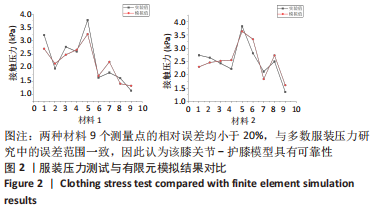

2.3 膝关节运动预测模拟结果 2.3.1 不同护膝材料对前交叉韧带的应力分布影响 在0°,30°,60°屈曲角度下,并且施加320 N垂直压缩力及134 N股骨后向推力后,膝关节无或穿戴护膝状态下,前交叉韧带峰值应力见表5,应力均集中在韧带前端,是较易产生损伤的部位。在穿着两种不同材料护膝运动后,前交叉韧带的峰值应力在0°和30°状态下均有所降低,材料2的效果较好,使其分别降低了7.9 MPa和1.09 MPa,材料1使其分别降低了6.38 MPa和0.26 MPa,但在屈曲60°状态下,韧带的峰值应力相较于无护膝时均有所上升,其中材料1使其上升10.82 MPa,材料2使其上升15.73 MPa,前交叉韧带在0°,30°,60°状态下的应力情况见图3。"
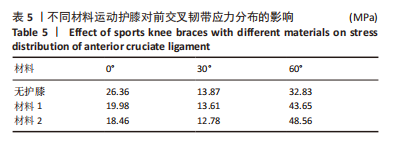

2.3.2 不同护膝材料对后交叉韧带的应力分布影响 在0°,30°,60°屈曲角度下,并且施加320 N垂直压缩力及134 N股骨后向推力后,膝关节无或穿戴护膝状态下,后交叉韧带的峰值应力见表6,峰值应力在屈曲过程中从股骨、胫骨连接处转移到后前侧,应力呈下降趋势。在穿着两种不同材料护膝运动后,后交叉韧带在屈曲0° 状态下均有所上升,材料1、材料2分别使其上升1.62 MPa和2.72 MPa;在屈曲30°与屈曲60°状态下,后交叉韧带的应力均有所降低,材料1使其降低0.47 MPa和0.45 MPa,材料2使其降低1.01 MPa和0.36 MPa,后交叉韧带在0°,30°,60°状态下的应力情况见图4。"
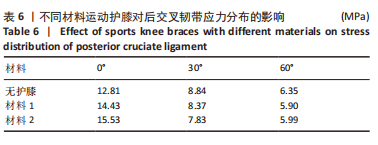
| [1] MAJEWSKI M, SUSANNE H, KLAUS S. Epidemiology of athletic knee injuries: A 10-year study. Knee. 2006;13(3):184-188. [2] POSCH M, SCHRANZ A, LENER M, et al. In recreational alpine skiing, the ACL is predominantly injured in all knee injuries needing hospitalisation. Knee Surg Sports Traumatol Arthrosc. 2021;29(6):1790-1796. [3] BROPHY RH, WOJTYS EM, MACK CD, et al. Factors associated with the Mechanism of ACL tears in the National Football League: A Video-Based Analysis. Orthop J Sports Med. 2021;9(11):23259671211053301. [4] MANIAR N, VERHAGEN E, BRYANT AL, et al. Trends in Australian knee injury rates: An epidemiological analysis of 228,344 knee injuries over 20 years. Lancet Reg Health West Pac. 2022;21:100409. [5] 陈凌娴,李俊,王敏.护膝防护性能及其功能设计研究进展[J].毛纺科技,2022,50(3):117-123. [6] MOON J, KIM H, LEE J, et al. Effect of wearing a knee brace or sleeve on the knee joint and anterior cruciate ligament force during drop jumps: A clinical intervention study. Knee. 2018;25(6):1009-1015. [7] 荆晓伟, 母应秀. 硅网支具对前交叉韧带损伤及膝关节稳定性的影响[J]. 中国组织工程研究,2020,24(4):505-510. [8] ALTHOMALI OW. Influence of using knee sleeve and lateral wedge insole on knee loading among healthy individuals during stair negotiation. Gait Posture. 2022;92:103-109. [9] VALLDECABRES R, DE BENITO AM, LITTLER G, et al. An exploration of the effect of proprioceptive knee bracing on biomechanics during a badminton lunge to the net, and the implications to injury mechanisms. Peer J. 2018;6:e6033. [10] JIANG T, TIAN S, FAN X, et al. Kinematics and kinetics of lower-extremity joints in parachuting landing with backpack and knee brace. Med Eng Phys. 2020;86:1-7. [11] BOTTONI G, HERTEN A, KOFLER P, et al. The effect of knee brace and knee sleeve on the proprioception of the knee in young non-professional healthy sportsmen. Knee. 2013;20(6):490-492. [12] KRAMI M, QIAN Z, ZOU Z, et al. Subject-specific finite element modelling of the human foot complex during walking: sensitivity analysis of material properties, boundary and loading conditions. Biomech Model Mechanobiol. 2018;17(2):559-576. [13] PENA E, CALVO B, MARTINEZ MA, et al. A three -dimensional finite element analysis of the combined behavior of ligaments and menisci in the healthy human knee joint. J Biomech. 2006;39(9):1686-1701. [14] 万超杰.人体大臂软组织活体力学特性分析[D].哈尔滨:哈尔滨工业大学,2017. [15] 何川,李彦林,张振光,等.不同屈曲状态下膝关节韧带生物力学的有限元分析[J].中国运动医学杂志,2015,34(7):662-669. [16] 孙亚博. 基于有限元模拟的针织服装穿着压力分析[D].天津:天津工业大学,2021. [17] GROOD ES, SUNTAY WJ. A joint coordinate system for the clinical description of three-dimensional motions: application to the knee. J Biomech Eng. 1983;105(2):136-144. [18] SKINNER H. Current diagnosis and treatment in orthopedics.USA: McGraw-Hill Professional Publishing. 2006. [19] 黎蒙. 女性羽毛球运动员头顶球单腿落地动作的膝关节生物力学有限元分析[D].上海:上海体育学院,2020. [20] GABRIEL MT, WONG EK, WOO SLY, et al. Distribution of in situ forces in the anterior cruciate ligament in response to rotatory loads. J Orthop Res. 2004;22(1):85-89. [21] SONG YH, DEBSKI RE, MUSAHL V, et al. A three -dimensional finite element model of the human anterior cruciate ligament: A computational analysis with experimental validation. J Biomech. 2004; 37(3):383- 390. [22] 万超,郝智秀,温诗铸.前交叉韧带力学特性差异对膝关节有限元仿真结果的影响[J].医用生物力学,2012,27(4):375-380. [23] SHERMAN MF, LIEBER L, BONAMO JR, et al. The long-term followup of primary anterior cruciate ligament repair. Defining a rationale for augmentation. Am J Sports Med. 1991;19(3):243-255. [24] YU A, YICK KL, NG SP, et al. Numerical simulation of pressure therapy glove by using Finite Element Method. Burns. 2016;42(1):141-151. [25] 于洁.基于人体臂部模型的服装压测试与数值模拟[D].天津:天津工业大学,2019. [26] CHEW KT, LEW HL, DATE E, et al. Current evidence and clinical applications of therapeutic knee braces. Am J Phys Med Rehabil. 2007; 86(8):678-686. [27] COUDEYRE E, NGUYEN C, CHABAUD A, et al. A decision-making tool to prescribe knee orthoses in daily practice for patients with osteoarthritis. Ann Phys Rehabil Med. 2018;61(2):92-98. [28] 庞欣.高弹护膝纺织品的开发与压力性能分析[D].杭州:浙江理工大学,2018. [29] 沈妙音.抗菌热湿舒适性服用机织物的研究与开发[D].杭州:浙江理工大学,2021. [30] 匡新谋,苏敏茹,李浩,等.预处理工艺对回收涤纶/锦纶/氨纶混合纤维改性聚丙烯力学性能影响[J].工程塑料应用,2020,48(9): 78-82. [31] WIGGINS AJ, GRANDHI RK, SCHNEIDER DK, et al. Risk of Secondary Injury in Younger Athletes After Anterior Cruciate Ligament Reconstruction: A Systematic Review and Meta-analysis. Am J Sports Med. 2016;44(7):1861-1876. [32] ANDRIACCHI TP, MÜNDERMANN A, SMITH RL, et al. A framework for the in vivo pathomechanics of osteoarthritis at the knee. Ann Biomed Eng. 2004;32(3):447-457. [33] FOCKE A, STEINGREBE H, MÖHLER F, et al. Effect of Different Knee Braces in ACL-Deficient Patients. Front Bioeng Biotechnol. 2020;8:964. [34] HOLDEN MA, CALLAGHAN M, FELSON D, et al. Clinical and cost-effectiveness of bracing in symptomatic knee osteoarthritis management: protocol for a multicenter, primary care, randomized, parallel-group, superiority trial. BMJ Open. 2021;11(3):e048196. [35] PIERRAT B, OULLION R, MOLIMARD J,et al. Characterisation of in-vivo mechanical action of knee braces regarding their anti-drawer effect.Knee. 2015;22(2):80-87. [36] MOHD SHARIF NA, USMAN J, WAN SAFWANI WKZ, et al. Effects of simple knee sleeves on pain and knee adduction moment in early unilateral knee osteoarthritis. Proc Inst Mech Eng H. 2019;233(11): 1132-1140. [37] SINCLAIR J, TAYLOR PJ. Effects of a Prophylactic Knee Sleeve on Anterior Cruciate Ligament Loading During Sport-Specific Movements. J Sport Rehabil. 2019;28(1):1-7. [38] BALTACI G, AKTAS G, CAMCI E, et al. The effect of prophylactic knee bracing on performance: balance, proprioception, coordination, and muscular power.Knee Surg Sports Traumatol Arthrosc. 2011;19(10): 1722-1728. [39] GIOTIS D, TSIARAS V, RISTANIS S, et al. Knee braces can decrease tibial rotation during pivoting that occurs in high demanding activities. Knee Surg Sports Traumatol Arthrosc. 2011;19:1347-1354. [40] FLEMING BC, RENSTROM PA, BEYNNON BD, et al. The influence of functional knee bracing on the anterior cruciate ligament strain biomechanics in weightbearing and nonweightbearing knees. Am J Sports Med. 2000;28(6):815-824. |
| [1] | Zhong Yizheng, Huang Peizhen, Cai Qunbin, Zheng Liqin, He Xingpeng, Dong Hang. Microstructural indexes that determine the trabecular bone maximum stress of micro-finite element models [J]. Chinese Journal of Tissue Engineering Research, 2023, 27(9): 1313-1318. |
| [2] | Wu Taoguang, Nie Shaobo, Chen Hua, Zhu Zhengguo, Qi Lin, Tang Peifu. Biomechanical characteristics of a new multi-dimensional cross locking plate in the treatment of subtrochanteric nonunion [J]. Chinese Journal of Tissue Engineering Research, 2023, 27(9): 1330-1334. |
| [3] | Peng Zhixin, Yan Wengang, Wang Kun, Zhang Zhenjiang. Finite element analysis and structural optimization design of 3D printed forearm braces [J]. Chinese Journal of Tissue Engineering Research, 2023, 27(9): 1340-1345. |
| [4] | Liu Jinyu, Zhang Hanshuo, Cui Hongpeng, Pan Lingzhi, Zhao Boran, Li Fei, Ding Yu. Finite element biomechanical analysis of minimally invasive treatment of cervical spondylotic myelopathy and accurate exercise rehabilitation [J]. Chinese Journal of Tissue Engineering Research, 2023, 27(9): 1359-1364. |
| [5] | Wen Xinghua, Ding Huanwen, Cheng Kai, Yan Xiaonan, Peng Yuanhao, Wang Yuning, Liu Kang, Zhang Huiwu. Three-dimensional finite element model analysis of intramedullary nailing fixation design for large femoral defects in Beagle dogs [J]. Chinese Journal of Tissue Engineering Research, 2023, 27(9): 1371-1376. |
| [6] | Liu Jiaxin, Jia Peng, Men Yutao, Liu Lu, Wang Yeming, Ye Jinduo. Design and optimization of bone trabecular structure with triply periodic minimal surfaces [J]. Chinese Journal of Tissue Engineering Research, 2023, 27(7): 992-997. |
| [7] | Li Huiqin, Wang Chunjuan, Wang Yu, Wang Weifeng, Chen Dinggen, Li Na. Clear aligner orthodontic therapy of rotated mandibular teeth with different shapes: a three-dimensional finite element analysis [J]. Chinese Journal of Tissue Engineering Research, 2023, 27(7): 1050-1054. |
| [8] | Li Xinyue, Li Xiheng, Mao Tianjiao, Tang Liang, Li Jiang. Three-dimensional culture affects morphology, activity and osteogenic differentiation of human periodontal ligament stem cells [J]. Chinese Journal of Tissue Engineering Research, 2023, 27(6): 846-852. |
| [9] | Liu Guangluan, Guo Zonglei, Ge Jin, Huang Dong, Wang Yehua. Anatomic risk factors for medial meniscus posterior root tears combined with anterior cruciate ligament injuries [J]. Chinese Journal of Tissue Engineering Research, 2023, 27(5): 663-668. |
| [10] | Wu Yujie, Wan Xiaofang, Wei Mianxing, Peng Shiyuan, Xu Xiaomei. Correlation between autophagy and the Hippo-YAP protein pathway in periodental ligament cells on the pressure side of a mouse model of orthodontic tooth movement [J]. Chinese Journal of Tissue Engineering Research, 2023, 27(5): 683-689. |
| [11] | Xiong Bohan, Yu Yang, Lu Xiaojun, Wang Xu, Yang Tengyun, Zhang Yaozhang, Liao Xinyu, Zhou Xiaoxiang, He Lu, Li Yanlin. Research progress in promoting tendon to bone healing during anterior cruciate ligament reconstruction [J]. Chinese Journal of Tissue Engineering Research, 2023, 27(5): 779-786. |
| [12] | Li Yaping, Liu Hong, Gao Zhen, Chen Xiaolin, Huang Wujie, Jiang Zheng. Three-dimensional motion analysis of lower limb biomechanical performance in Tai Chi practitioners accompanied by knee joint pain [J]. Chinese Journal of Tissue Engineering Research, 2023, 27(4): 520-526. |
| [13] | Li Shihao, Li Qi, Li Zhen, Zhang Yuanyuan, Liu Miaomiao, Ouyang Yi, Xu Weiguo. Plantar pressure and gait analysis in patients with anterior cruciate ligament injury and reconstruction [J]. Chinese Journal of Tissue Engineering Research, 2023, 27(4): 626-631. |
| [14] | Chen Peng, Wang Ling, Dong Shiyu, Ding Yue, Jia Shaohui, Kou Xianjuan, Zheng Cheng. Effects of whole-body vibration training on anterior cruciate ligament reconstruction: a meta-analysis [J]. Chinese Journal of Tissue Engineering Research, 2023, 27(36): 5875-5883. |
| [15] | Wen Pengfei, Li Yaning, Lu Yufeng, Hao Linjie, Wang Yakang, Ma Tao, Song Wei, Zhang Yumin. Establishment of lumbar-pelvic-hip finite element model and biomechanical analysis [J]. Chinese Journal of Tissue Engineering Research, 2023, 27(36): 5741-5746. |
| Viewed | ||||||
|
Full text |
|
|||||
|
Abstract |
|
|||||

